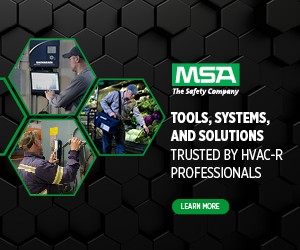Managing the First 30 Minutes
Once the clock starts ticking, every minute is critical. To successfully control the situation, facilities must prepare in advance, leadership roles must be clearly defined and first responders must be able to take action without waiting for Hazmat teams to arrive on the scene.
In 2013, the Ammonia Safety and Training Institute worked with IIAR to develop a training video and workbook called “Module 5 – Making the First 30 Minutes of Emergency Response Count” that was designed to address this issue – that training is now available at the IIAR bookstore.
And module 5 went beyond providing training recommendations around existing federal rules that limited the ability of on-site facility “non-technician responders” from working in the danger area. The training video and workbook went on to show how certified emergency response technicians were allowed to take action with levels of ammonia vapor (5,000 parts per million) without having to wear a fully encapsulated entry suit. As a result, much-needed shutdown and rescue procedures were not delayed.
But now, ASTI and the International Institute of Ammonia Refrigeration are working with the Occupational Safety and Health Administration and the Environmental Protection Administration on a best management practices standard of operation that simplifies and focuses on-site and public safety first responders to safely engage in the first 30 minutes when working in less than 5,000 to 10,000 ppm ammonia vapor. Gary Smith, ASTI president, calls this new plan “a game-changer.”
“Our best management practice recommendations will legitimize the 30-minute plan. Time will no longer be wasted as the Emergency Action Plan is being implemented. It’s a new day for a better way,” Smith said. “Plant operators and first responders must be trained and equipped to do more during the first 30 minutes to shut down the threat without losing their “non-responder” protection afforded under the Emergency Action Plan standard.
“The operators and first responders must act quickly to gauge what is happening so that the Incident Commander can properly set an action plan that contains the problem and moves quickly to protect lives, just as is the case for fire and any other emergency event that they face on a day-to-day basis,” he said. “We want to eliminate the chaos and stop problems when they are small – to prevent injury and minimize the damages of what could otherwise develop into a devastating emergency event.”
Federal guidelines stipulate that trained and equipped refrigeration operators can engage critical operations during an emergency event when they are following a pre-arranged procedure that has been documented as standard operating procedure. An example of this is implementing a hazard zone emergency shutdown procedure. “If you’re working in under 5,000 parts-per-million ammonia vapor and you’re wearing protective clothing that covers all skin, and a self-contained breathing apparatus, there is minimal risk to the responder,” Smith said. “With that in mind, we went back and set a new limit where it is viable for a trained operator working under the scope of an Emergency Action Plan (non-certified emergency responder) to safely initiate the implementation of a SOP that you have already determined will shut down the hazard zone,” he said. “Furthermore, a trained operator may make a rescue if conditions are within the scope of the PPE as defined within the standard of operation.”
ASTI and IIAR are working with OSHA and EPA so that these changes become recognized and generally accepted good engineering practices. The RAGAGEP could then be used by private and public safety responders to demonstrate how they can address emergencies without being fully certified emergency response technicians.
“OSHA and EPA understand the need for our facilities to respond early to prevent a minor situation from turning into something major,” said David Rule, IIAR president. “They understand that our intent is to protect the safety of the workers and prevent any neighbors from being put at risk.”
ASTI has been communicating with fire departments and other first responders to educate them on how the new plan will work. ASTI will hold 15 safety days across the county this year highlighting its best plan for managing the first 30 minutes. ASTI plans live releases of less than 10,000 parts-per-million in four states that will demonstrate to lead responders how to get in and get out, and do what they need in 10 minutes without any ammonia safety issues.
“It’s really important for our facilities to train and prepare their people,” Rule said. “They need to know the right steps so they can take action to prevent a minor situation from developing into a critical situation.
“We also want to reach out to first responders to ensure we have good communication and that they are properly trained to address an ammonia release,” he said.
ASTI is developing a commandteam presence that works with public safety response, so that a first responder is immediately met by an Incident Commander who provides a “Conditions-Actions-Needs” (C-A-N) report that clearly sets the stage for joint operations. The public safety first responders should work in sync with the facility response team to complete the initial response of the emergency shutdown or rescue.
Finally, the plan recommends that facilities adopt a pre-emergency readiness procedure. If an event is taking place that poses an increased level of risk, such as opening up the system to change a valve, the appropriate emergency personnel should be informed in advance.
“It only takes 5 to 10 minutes to set up the pre-emergency readiness checklist (assuring that safety measures, PPE, and control points are reviewed, and that the facility IC is notified). So if something goes wrong, the lead responder contacts the plant incident commander, who notifies the evacuation group supervisor and the notification leader and the action plan begins without delay. Every time you do that the team has a chance to set up preemergency readiness they exercise their skills and get a better understanding of how to engage their positions,” he said.
Smith concluded, “With this plan we now have a methodology. We have playbooks for life safety and emergency shutdown procedures that are engaging and easy to follow. If the emergency event continues to grow beyond the first 30 minutes (discovery and initial response phases), the first responder team will be ready to transition command and control to the in-coming hazmat technician responders. A sustained response will occur that will eventually lead to the termination phase, and the emergency event will have a much less costly ending than has often been the case in the past.”















